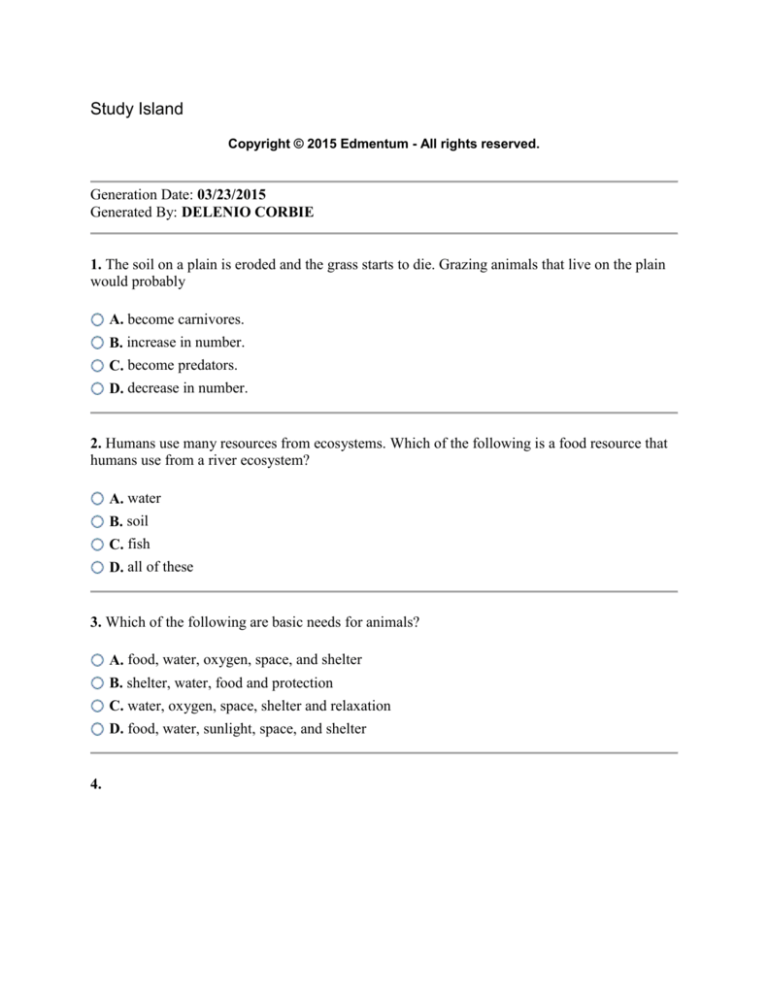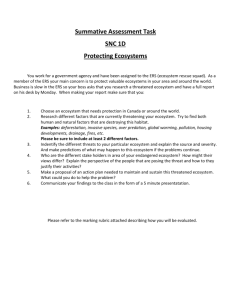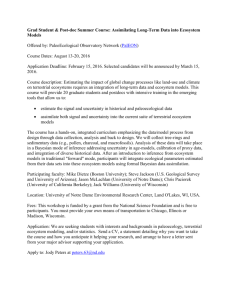
Study Island
Copyright © 2015 Edmentum - All rights reserved.
Generation Date: 03/23/2015
Generated By: DELENIO CORBIE
1. The soil on a plain is eroded and the grass starts to die. Grazing animals that live on the plain
would probably
A. become carnivores.
B. increase in number.
C. become predators.
D. decrease in number.
2. Humans use many resources from ecosystems. Which of the following is a food resource that
humans use from a river ecosystem?
A. water
B. soil
C. fish
D. all of these
3. Which of the following are basic needs for animals?
A. food, water, oxygen, space, and shelter
B. shelter, water, food and protection
C. water, oxygen, space, shelter and relaxation
D. food, water, sunlight, space, and shelter
4.
What would most likely happen in the ecosystem shown in the above food web if the fox
population significantly increased?
A. The population of bees would increase.
B. The population of black bears would increase.
C. The population of mice would decrease.
D. The population of mice would increase.
5. A population of 120 rabbits lives in a prairie ecosystem. Which of these might prevent this
population from growing any larger?
A. a decreasing amount of competition for space
B. a disease with a high mortality rate
C. a decreasing amount of predators
D. an increasing amount of edible plant life
6. Sewage that ends up in waterways can increase algae growth because it
A. provides nutrients.
B. kills plants.
C. uses oxygen.
D. attracts birds.
7. Humans usually live in houses or other buildings that protect them from environmental
hazards, such as rain, snow, and extremely hot and cold temperatures. The roofs of buildings
may be made from a variety of materials. Which of the following is a renewable resource that
can be used to make roofs?
A. copper
B. aluminum
C. wood
D. all of these
8. In an ecosystem, there are many factors that affect how many organisms can survive there.
Which of the following is one of those factors?
A. number of times humans have seen the area
B. availability of water
C. age of mammal species
D. color of flowering plants
9. In any ecosystem, the size of a population
A. only depends on the amount of resources available.
B. always stays the same.
C. may change over time.
D. only depends on the population's reproductive rate.
10.
Look at the diagram above of a marine food web. What might happen to this ecosystem if the
non-native populations of smelt and alewife increase greatly?
A.
The smelt and alewife may out-compete the native fish by consuming all of the
zooplankton.
B. The salmon will starve.
C. The smelt will eat the alewife.
Nothing should happen to this ecosystem if the populations of smelt and alewife increase
D.
greatly.
11. The graph below shows the population size of a predator and its prey in a community.
Look at the prey's population size at the end of the graph.
How will this population size most likely change next?
A. There is no way to predict how the population size will change.
B. The population size will remain the same.
C. The population will increase in size.
D. The population will shrink in size.
12. A population in an ecosystem cannot grow indefinitely. There are limiting factors in each
ecosystem that keep a population within a certain size range. Which of the following is most
likely NOT a limiting factor for a population of deer in a forest ecosystem?
A. the number of mountain lions present
B. the amount of edible plants available
C. the amount of space in the forest
D. the number of perching birds present
13. Which of the following is a living factor in an ecosystem that could limit the size of a
raccoon population?
A. the availability of water
B. competition from other animals
C. a very cold winter
D. a forest fire
14. A species of seabird nests every year on the face of one wall of cliffs on one island. If these
birds nest on the ground above the cliffs, they run a high risk of having their eggs eaten by
predatory snakes.
There are only about 5,000 suitable nesting sites in the cliffs. And there are about 8,000 seabirds
looking to nest. The only other option for these nesting seabirds, would be to nest in the rocks of
a neighboring island. But if they do this, they run the risk of losing the flock, and missing out on
breeding season.
Which of these is placing a limitation on how large this population of seabirds can grow?
A. the distance to neighboring islands
B. the number of snakes living on land
C. the size of the cliff walls
D. all of these
15. There are two types of factors that change environments. These are biotic factors
and _______ factors.
A. organic
B. abiotic
C. biological
D. genetic
16. Fungi do not produce their own food. Many kinds of fungi get food by living in or on other
organisms, such as plants, and taking nutrients from these organisms.
Which of the following will most likely happen if a fruit tree is infected by a fungus?
A.
B.
C.
D.
The fruit tree will use the fungus as food.
The fruit tree will grow more slowly and may eventually die.
The fruit tree will grow faster and produce larger fruit.
The fruit tree will not be affected by the fungus in any way.
17. The following diagram represents how energy flows through ecosystems:
sunlight
plants
herbivores
carnivores
What would most likely occur in an ecosystem if a nearby volcano erupted and filled the sky
with dust particles, which caused significantly less sunlight to reach the ecosystem over the
course of a year?
Many plants would die, but the animals would survive.
A.
B.
C.
D.
Many plants and animals would die off.
The plants would begin using nutrients in the soil for energy.
The lack of sunlight would not significantly impact the ecosystem.
18. The Canadian lynx is a large wild cat that lives in the cold regions of Canada. The snowshoe
hare is the main prey species that is hunted by the Canadian lynx. The snowshoe hare eats grass,
fern, and leaves.
If the population of Canadian lynx were to completely disappear, what would most likely happen
to the food supply of the snowshoe hare?
A.
The snowshoe hare would stop eating grass, so there would be less food available.
The population of snowshoe hare would outgrow the food supply, so there would be less
B. food available.
The snowshoe hare would start eating each other, so the food supply would not be
C. affected.
D.
The population of snowshoe hare would decrease, and there would be more food available.
19. Humans have many basic needs, including food, water, and clothing. Which of the following
renewable resources can provide humans with the materials that they need to make clothing?
A. cotton from plants
B. wool from sheep
C. hides from cattle
D. all of these
20. A food web is shown below.
A drought in this ecosystem makes the ground become very dry. Which of the following would
most likely result from this change?
The grass will grow more rapidly, which will cause a decrease in the impala population.
A.
B.
C.
D.
The grass will grow more rapidly, which will cause a decrease in the cheetah population.
The grass will shrivel and die, which will cause an increase in the cheetah population.
The grass will shrivel and die, which will cause a decrease in the impala population.
21. A certain population of bluebirds eats spiders as a major food source.
Which of the following ecosystem changes would impact this population of bluebirds the most?
A. a decrease in the number of daylight hours
B. an increase in the spider and insect population
C. a decrease in the rabbit population
D. an increase in the fish population
22. If given adequate resources, populations can grow at rapid rates. For example, one female
mouse can produce a litter of four to fourteen babies every three to four weeks throughout her
life. This population growth would most likely be limited by
A. an increase in the size of the mice's living space.
B. a decrease in the local owl population.
C. a disease which infects the baby mice shortly after birth.
D. fair weather and a consistent climate.
23.
What would most likely happen in the ecosystem shown in the above food web if a disease
caused a major decrease in the cheetah population?
A. The impala population would increase.
B. The grass population would increase.
C. The impala population would decrease.
D. The lion population would decrease.
24. Zebra mussels, shown below, have recently been found in Colorado lakes.
The mussels are not native to the lakes, and they have begun to kill native mussels by attaching
to them and covering them up. The zebra mussels are
A. a cooperative species.
B. an invasive species.
C. a pioneer species.
D. a hybrid species.
25. Which statement below accurately describes the carrying capacity of any ecosystem?
A. It is not affected by any abiotic or biotic resources.
B. It is completely dependent upon the food supply.
C. It is affected by both abiotic and biotic resources.
D. It does not affect the species of an ecosystem.









